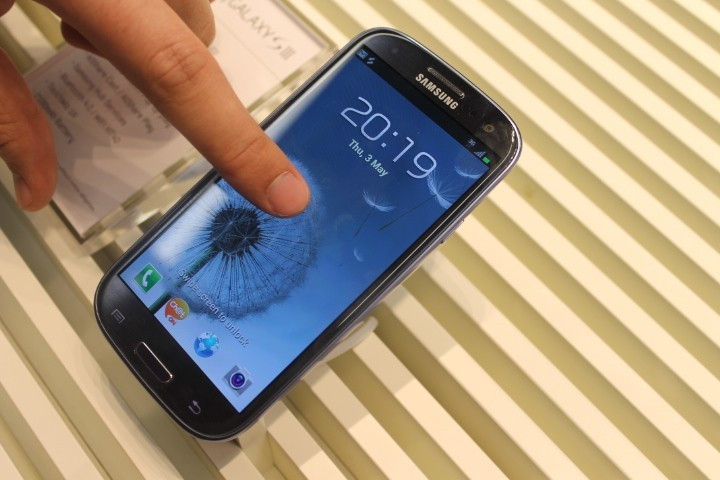Samsung Galaxy S3 Vs LG Optimus LTE: Which LTE Smartphone is Best?
LG Optimus LTE, Optimus Vu and Optimus LTE Tag will get the Android 4.0 Ice Cream Sandwich upgrade on 4 June.
We compare the newly launched Samsung Galaxy S3 and LG optimus LTE to find out which is the best smartphone with LTE connectivity.

The LG Optimus LTE with 4G connectivity was announced in October. The 4.5in True HD IPS display of the smartphone offers advanced resolution, brightness and clarity. The Optimus LTE delivers enhanced performance with 1.5GHz dual-core processor.
With its 1800mAh battery the smartphone is well suited for multimedia usage. In addition, it is capable of sharing content through HDMI and Digital Living Network Alliance (DLNA); the phone also has NFC for contactless mobile payments.
LG has announced that the Optimus LTE along with Optimus Vu and Optimus LTE Tag will get the Android 4.0 Ice Cream Sandwich upgrade on 4 June. The ICS update include LG's latest user interface, version 3.0.

Display
The LG Optimus LTE features a 4.5in HD-IPS LCD capacitive touchscreen and has what LG is calling a True HD Graphic Engine. The resolution of the display is 720 x 1280 pixels with a pixel density of 326 pixels per inch.
The Galaxy S3 features a Super AMOLED capacitive touchscreen protected with Corning Gorilla Glass 2. The display has Samsung's TouchWiz User Interface v4.0 and the resolution of the display is similar to the LG Optimus, at 720x1280 pixels with a density of 306 ppi.
Dimension
The LG Optimus measures 132.9 x 67.9 x 10.4mm and weighs 139g while the Galaxy S3 measures 136.6x70.6x8.6mm and weighs slightly less at 133g.
Operating System
The LG Optimus was launched with the Android 2.3.5 Gingerbread but it can be upgraded to 4.0 Ice Cream Sandwich. The Galaxy S3 also runs on Android 4.0 ICS, which it comes with out of the box.
Processor
The LG Optimus is powered by a Qualcomm MSM8660 Snapdragon chip with dual-core 1.5GHz Scorpion processor. The Galaxy S3 is powered by the Exynos 4 quad-core processor, clocked at 1.4GHz. Both smartphones have 1GB of RAM.
Camera
The LG Optimus packs an eight megapixel with auto-focus, LED flash, geo-tagging, face detection and image stabilisation. The camera can record video in 1080p at 30 frames per second and the flash can be used as a light while recording. The handset has a 1.3 megapixel front-facing camera.
The Galaxy S3 is equipped with a rear camera of eight megapixels with auto-focus, LED flash and other features such as simultaneous HD video and image recording, geo-tagging, touch-focus, face and smile detection and image stabilisation.
The camera can record video in 1080p at 30 frames per second, the same as the LG. Samsung's S3 packs a front-facing camera of 1.9 megapixels, which can record video in 720p at 30 fps.
Connectivity
The LG Optimus offers 802.11 a/b/g/n, Wi-Fi Direct, DLNA, Wi-Fi hotspot and Bluetooth version 3.0 with A2DP and HS. It supports both HSDPA and LTE fotr super-fast browsing and NFC for contactless mobile payments.
The Galaxy S3 offers Wi-Fi a/b/g/n, Wi-Fi HT40, NFC and Bluetooth v4.0. It supports data speeds up to HSDPA 21Mbps and HSUPA 5.76 Mbps and can connect to 4G (also known as LTE) networks.
Storage
The LG Optimus offers a storage option of 4GB and has a microSD card slot which can support cards up to 32GB in size.
The S3 has two models - 16/32GB, with a 64GB model expected to be available soon. The smartphones also supports microSD to bump the storage up even more. Vodafone will sell the 32GB model exclusively for the first four weeks, after which it will be sold by the other networks as well.
Battery
The LG Optimus is powered by a 1830mAh battery delivering a claimed talk time of up to seven hours. The Galaxy S3 has a larger 2100mAh battery and delivers a claimed talk time of up to 21 hour and 40 minutes in 2G and an impressive 11 hours and 40 minutes in 3G, although we are yet to test these claims.
© Copyright IBTimes 2025. All rights reserved.



















